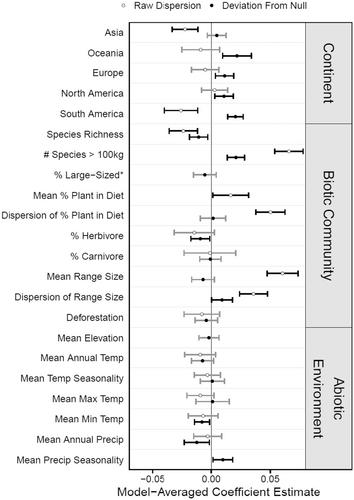The species that compose local communities possess unique sets of functional and ecological traits that can be used as indicators of biotic and abiotic variation across space and time. Body size is a particularly relevant trait because species with different body sizes typically have different life history strategies and occupy distinct niches. Here we used the body sizes of non-volant (i.e., non-flying) terrestrial mammals to quantify and compare the body size disparity of mammal communities across the globe.
Global.
Present.
Non-volant terrestrial mammals.
We used IUCN range maps of 3982 terrestrial mammals to identify 1876 communities. We then combined diet data with data on climate, elevation and anthropogenic pressures to evaluate these variables' relative importance on the observed body size dispersion of these communities and its deviation from a null model.
Dispersion for these communities is significantly greater than expected in 54% of communities and significantly less than expected in 30% of communities. The number of very large species, continent, range sizes, diet disparity and annual temperature collectively explain > 50% of the variation in observed dispersion, whereas continent, the number of very large species, and precipitation collectively explain > 30% of the deviation from the null model.
Climate and elevation have minimal predictive power, suggesting that biotic factors may be more important for explaining community body size distributions. However, continent is consistently a strong predictor of dispersion, likely due to it capturing the combined effects of climate, size-selective human-induced extinctions and more. Overall, our results are consistent with several plausible explanations, including, but not limited to, competitive exclusion, unequal distribution of resources, within-community environmental heterogeneity, habitat filtering and ecosystem engineering. Further work focusing on other confounding variables, at finer spatial scales and/or within more causal frameworks is required to better understand the driver(s) of these patterns.



